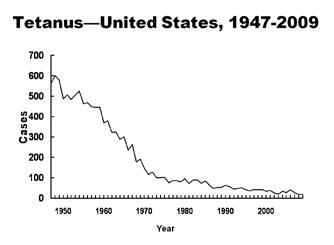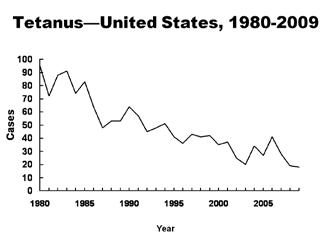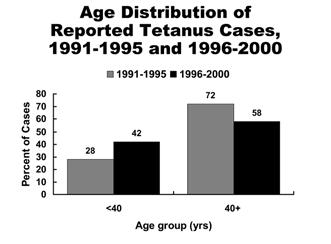Tetanus epidemiology and demographics
|
Tetanus Microchapters |
|
Diagnosis |
|---|
|
Treatment |
|
Case Studies |
|
Tetanus epidemiology and demographics On the Web |
|
American Roentgen Ray Society Images of Tetanus epidemiology and demographics |
|
Risk calculators and risk factors for Tetanus epidemiology and demographics |
Editor-In-Chief: C. Michael Gibson, M.S., M.D. [1]; Associate Editor(s)-in-Chief: Usama Talib, BSc, MD [2]
Overview
Tetanus is an infectious disease which is not know to be contagious and can be prevented with a vaccine. There are less than 100 cases of tetanus in the US and around five deaths can be attributed to tetanus every year. There are about one million cases of tetanus reported worldwide. These according to an estimate lead to 300,000 to 500,000 deaths every year. The incidence of tetanus in the United States is 0.01 cases per 100,000 individuals. Tetanus is more commonly seen in Hispanics. Individuals greater than age 65 have a higher incidence of tetanus. Tetanus has a case fatality rate of 13.2%.[1][2][3][4] [5][6][7]
Epidemiology and Demographics
Incidence
- Between 2001 and 2008 the general incidence of tetanus in the United States was calculated to be 0.01 cases per 100,000 individuals. [1][2][3][4] [5][6][7]
- The incidence of tetanus for individuals with age more than 65 years is estimated to be 0.023 cases per 100,000 individuals.
- The incidence of tetanus in England and Whales is 0.02 cases per 100,000 individuals.
Prevalence
- The prevalence of tetanus throughout the world is almost 1 million cases.[8]
- The prevalence of tetanus in the US is less that 100 cases.
Case Fatality Rates
- Tetanus is a life threatening disease.
- There is variation in data regarding the case fatality rates of tetanus in various populations.
- The annual case fatality rate of tetanus is approximately 13.2 %.
- The case fatality rate of tetanus in developing countries is 8-50%.
- The mortality rate of neonatal tetanus is 3-88%.
- Neonatal tetanus is associated with 14% of overall neonatal deaths.
Age
- The incidence of tetanus is greater in individuals older than age 65.
Race
- Tetanus is more prevalent in Hispanics.
- Hispanics are two times more prone to have tetanus as compared to non-Hispaic individuals.
Developed Countries
- Tetanus is less common in developed countries.[9]
- There has been a 95% decrease in the reported cases of tetanus in the United States.
- Deaths in the United States as a result of tetanus have declined by 99%.
- The incidence of tetanus in England and Whales is 0.02 cases per 100,000 individuals.
Developing Countries
- Tetanus is more common in developing countries as compared to the developed countries.[9]
Trends of Tetanus in the USA
A marked decrease in mortality from tetanus occurred from the early 1900s to the late 1940s. In the late 1940s, tetanus toxoid was introduced into routine childhood immunization and tetanus became nationally notifiable. At that time, 500–600 cases (approximately 0.4 cases per 100,000 population) were reported per year. After the 1940s, reported tetanus incidence rates declined steadily. Since the mid-1970s, 50–100 cases (~0.05 cases per 100,000) have been reported annually. From 2000 through 2007 an average of 31 cases were reported per year. The death-to-case ratio has declined from 30% to approximately 10% in recent years. An all-time low of 18 cases (0.01 cases per 100,000) was reported in 2009. From 1980 through 2000, 70% of reported cases of tetanus were among persons 40 years of age or older. From 1980 through 1990, a median of 21% of reported cases were among persons younger than 40 years of age. The age distribution of reported cases shifted to a younger age group in the last half of the 1990s. Persons younger than 40 years accounted for 28% of cases during 1991–1995, increasing to 42% of cases during 1996–2000. This change in age distribution is a result of both an increase in cases in persons younger than 40 years and a decrease in cases in older people. The increase in cases among younger persons is related in part to an increased number of cases among young injection-drug users in California in the late 1990s.[1]
Almost all reported cases of tetanus are in persons who have either never been vaccinated, or who completed a primary series but have not had a booster in the preceding 10 years. Heroin users, particularly persons who inject themselves subcutaneously, appear to be at high risk for tetanus. Quinine is used to dilute heroin and may support the growth of C. tetani. Neonatal tetanus is rare in the United States, with only two cases reported since 1989. Neither of the infants' mothers had ever received tetanus toxoid. During 1998–2000 (the most recent years for which compiled data are available), acute injuries or wounds preceded tetanus in 94 (73%) of the 129 cases for which information was available. Among the most frequent wound types were puncture wounds (50%), lacerations (33%), and abrasions (9%). The most common puncture wound was from stepping on a nail (15 cases). Other puncture wounds involved barbed wire, splinters, animal or insect bites, self-piercing, and self performed tattoos. The environment in which acute injuries occurred was indoors or at home in 45%, in the yard, garden, or farm in 31%, and other outdoor locations in 23%. Five percent of reported case-patients were intravenous drug users without other known injury, and 11% had chronic wounds. Twenty patients were reported to have received at least a primary series of tetanus toxoid; 18 had an outcome reported. Among these 18 patients, one (6%) death occurred; the death was in an injection-drug user whose last dose of tetanus toxoid was 11 years before the onset of tetanus. A total of 110 patients reported fewer than three doses of tetanus toxoid or had an unknown vaccination history; 95 of these patients had an outcome reported. Nineteen (20%) deaths occurred among these 95 patients.[1]
References
- ↑ 1.0 1.1 1.2 1.3 Centers for Disease Control and Prevention (CDC) (2011). "Tetanus surveillance --- United States, 2001-2008". MMWR Morb Mortal Wkly Rep. 60 (12): 365–9. PMID 21451446.
- ↑ 2.0 2.1 "Pinkbook | Tetanus | Epidemiology of Vaccine Preventable Diseases | CDC".
- ↑ 3.0 3.1 Rushdy AA, White JM, Ramsay ME, Crowcroft NS (2003). "Tetanus in England and Wales, 1984-2000". Epidemiol Infect. 130 (1): 71–7. PMC 2869940. PMID 12613747.
- ↑ 4.0 4.1 Thwaites CL, Beeching NJ, Newton CR (2015). "Maternal and neonatal tetanus". Lancet. 385 (9965): 362–70. doi:10.1016/S0140-6736(14)60236-1. PMID 25149223.
- ↑ 5.0 5.1 C. Louise Thwaites, Nicholas J. Beeching & Charles R. Newton (2015). "Maternal and neonatal tetanus". Lancet (London, England). 385 (9965): 362–370. doi:10.1016/S0140-6736(14)60236-1. PMID 25149223. Unknown parameter
|month=ignored (help) - ↑ 6.0 6.1 Martha H. Roper, Jos H. Vandelaer & Francois L. Gasse (2007). "Maternal and neonatal tetanus". Lancet (London, England). 370 (9603): 1947–1959. doi:10.1016/S0140-6736(07)61261-6. PMID 17854885. Unknown parameter
|month=ignored (help) - ↑ 7.0 7.1 M. H. Trujillo, A. Castillo, J. Espana, A. Manzo & R. Zerpa (1987). "Impact of intensive care management on the prognosis of tetanus. Analysis of 641 cases". Chest. 92 (1): 63–65. PMID 3595250. Unknown parameter
|month=ignored (help) - ↑ Afshar M, Raju M, Ansell D, Bleck TP (2011). "Narrative review: tetanus-a health threat after natural disasters in developing countries". Ann Intern Med. 154 (5): 329–35. doi:10.7326/0003-4819-154-5-201103010-00007. PMID 21357910.
- ↑ 9.0 9.1 World Health Organization (2000-11-01). "Maternal and Neonatal Tetanus Elimination by 2005" (PDF). Retrieved 2007-01-26.




